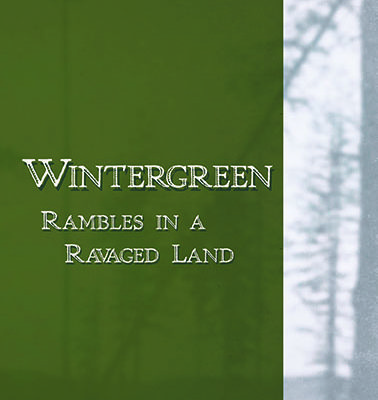
Wintergreen: Rambles in a Ravaged Land By Robert Michael Pyle
In the world of publishing, 30 years is a long time between editions of a book. For an ecosystem, not so long.
It was 1986 when Robert Michael Pyle, a naturalist living at Gray’s River in the Willapa Hills of Southwest Washington, wrote “Wintergreen: Rambles in a Ravaged Land.” It was a story of place and the Willapa, a prime tree-growing expanse of the coast range, was the main character. Supporting characters included the rain, lichen, moss, underbrush, salamanders, salmon, butterflies and everything else in the forests. This is a book that will help you understand the complexity of a forest ecosystem. Other characters include the Big Timber logging outfits and loggers – some of them Pyle’s neighbors – who seemed hell bent on cutting the forest down and this is also a book about the complexity of humans as part of the ecosystem.
You don’t need to have read the book to know that the timber companies got the upper hand, at least in the near term.
But nothing is simple and Pyle addresses that in the Afterward he has written for a new edition of the book, released late last year by Pharos Editions. Pharos is dedicated to reprinting “out of print, lost or rare books of distinction.” The books are chosen on the recommendations of notable authors. In this case David Guterson, the Bainbridge Island author of “Snow Falling on Cedars,” championed “Wintergreen.”
The Willapa is roughly defined as that area from Interstate 5 to the coast and stretching north from the Columbia River to Grays Harbor and the Chehalis River. Pyle writes lovingly and personally about the Willapa, with a dual perspective that ranges from lyrical to scientific. By the end of “Wintergreen” you’ll know about the geology, the climate, the flora and the fauna of the place. You’ll also know about the human climate, those who logged the area and those who tried to preserve it.
To be sure, the human effect on the Willapa has been profound, but the ecosystem perseveres, as it always has. Pyle spent much of the first edition describing the pressure that logging has put on that system, but reassuring us that nature would win out, despite us, not because of us. A perspective of 30 years makes it clearer still. As Pyle writes in the new Afterward:
“ … In real communities of humans and other species, sharp endings seldom occur; life is preparation for change, and the stories go on and on, like the land.”
In the Afterward, he finds consolation in the few relatively small patches of old-growth that were saved by the indefatigable work of preservationists, but laments that in the heat of the battle not enough attention was paid to saving the advanced second growth forests beginning to show the diverse signs of old growth.
“In short, these were woods on their way to becoming real forests. We took a lot of pleasure in them, and yet we also took them for granted, because they were not old growth. How could we have known that vast tracts of the good secondary woods would be liquidated in between editions of this book – literally shaven in fifteen years’ time. Woods that could and should have provided jobs, fiber and diversity for fifty years plus.”
Lucrative export markets and extra pressure on private timberlands because federal lands were off limits hastened the timber harvests in those years. Ironically, he points out, one of the biggest reasons for the accelerated loss of the second growth has been the transfer of lands from the old guard Big Timber owners such as Weyerhaeuser and Crown Zellerbach — which he chided in the first edition — to new corporate landowners who were more about being land companies than foresters.
In the Afterward, Pyle writes of new threats to the Willapa. He calls them the three C’s: carbon, climate and catastrophe.
Carbon threatens in the form of possible oil and natural gas shipping facilities that could be sited on the coast. The forest already shows signs of a warming climate that may someday make life harder in the Willapa, and catastrophe lurks in the form of a megaquake and tsunami already overdue.
But the Willapa’s story of place will always have new chapters. As he wrote in the first edition:
“The land has been hurt. Misuse is not to be excused, and its ill effects will long be felt. But nature will not be eliminated, even here. Rain, moss and time apply their healing bandage, and the injured land at last recovers.
Nature is evergreen, after all.”

The Author: Robert Michael Pyle published the first edition of Wintergreen in 1986 about the Willapa. The reprint includes an extended Afterward.
The Author-Robert Michael Pyle published the first edition of Wintergreen in 1986 about the Willapa. The reprint includes an extended Afterword.
Info: Wintergreen: Rambles In A Ravaged Land. Robert Michael Pyle. Pharos Editions, an imprint of Counterpoint, 2015. Pp 364.